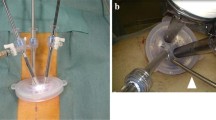Abstract
Background
Minimal access surgery has revolutionized surgery practice. Its proven advantages, such as reduced postoperative pain, early return to unrestricted activities, and better cosmesis, have become important drivers for its rapid development. In sub-Saharan Africa this development has been slow. The aim of the current study was to describe the challenges and outcomes of laparoscopic procedures in a public hospital that caters to a predominantly rural population.
Material and methods
The first 100 patients who underwent laparoscopic procedure in the Department of Surgery at Federal Medical Centre, Owerri, Nigeria were retrospectively analyzed. Data were retrieved from the medical records department as well as the surgical theater procedure register. The focus of the study was on patient demographics, indication for surgery, procedure performed, length of hospital stay, and morbidity and mortality data. Staff training was done locally and abroad.
Results
Altogether, 100 patients had laparoscopic surgery in our general surgery unit from September 2007 through July 2013. The ages of the patients was 5–75 years (median 36.5 years). The three main procedures were cholecystectomy (36 %), diagnostic laparoscopy (29 %), and appendectomy (21 %). The other operations performed included liver abscess drainage (7 %), adhesiolysis (3 %), hernia repair (1 %), and Heller’s myotomy (1 %). Four cases were converted to open surgery. There were no deaths. There were 14 grades I and II postoperative complications in nine patients.
Conclusions
Our study suggests that basic laparoscopic procedures could be offered safely to our resource-poor rural population. It is a platform on which we can hopefully introduce advanced laparoscopic surgical operations.

Similar content being viewed by others
References
Bowen JC (2008) Evolution of a surgeon: a 40-year perspective. J Gastrointest Surg 12:2051–2056
Choy I, Kitto S, Adu-Aryee N et al (2013) Barriers to the uptake of laparoscopic surgery in a lower-middle-income country. Surg Endosc 27:4009–4015
Oak SN, Parelkar SV, Akhtar T et al (2005) Minimal access surgery in children: 5 years institutional experience. J Minim Access Surg 1:121–123
Rivas H, Diaz-Calderon D (2013) Present and future advanced laparoscopic surgery. Asian J Endosc Surg 6:59–67
Adisa AO, Lawal OO, Arowolo OA et al (2013) Local adaptations aid establishment of laparoscopic surgery in a semi urban Nigerian hospital. Surg Endosc 27:390–393
Bode CO, Nwawolo CC, Giwa-Osagie OF (2008) Surgical education at the West African College of Surgeons. World J Surg 32:2162–2166. doi:10.1007/s00268-008-9710-x
Ekwunife CN, Chianakwana GU, Anyanwu SN et al (2012) Pioneering laparoscopic surgery in south-eastern Nigeria: a two-center general surgery experience. Niger J Basic Clin Sci 9:75–78
Dindo D, Demartines N, Clavien PA (2004) Classification of surgical complications: a new proposal with evaluation in a cohort of 6336 patients and results of a survey. Ann Surg 240:205–213
Okrainec A, Smith L, Azzie G (2009) Surgical simulation in Africa: the feasibility and impact of a 3-day fundamentals of laparoscopic surgery course. Surg Endosc 23:2493–2498
Loveland J, Numangolu A (2012) Paediatric minimally invasive surgery in Africa: limitations and current situation. Semin Paediatr Surg 21:160–163
Bendinelli C, Leal T, Moncade F et al (2002) Endoscopic surgery in Senegal: benefits, costs and limits. Surg Endosc 16:1488–1492
Misauno MA, Ojo EO, Uba AF (2012) Laparoscopic paediatric surgery: a potential for paradigm shift in developing countries. Afr J Paediatr Surg 9:140–142
Baigrie RJ, Stupart D (2010) Introduction of laparoscopic colorectal cancer surgery in developing countries. Br J Surg 97:625–627
Udwadia TE (2002) Diagnostic laparoscopy: a 30 year review. Surg Endosc 18:6–10
Ekenze SO, Nwankwo EP, Okere PCN (2012) The utility of ultrasonography in the management of undescended testis in a developing country. World J Surg 37:1121–1124. doi:10.1007/s00268-012-1532-1
Ekwunife CN, Njike CI (2013) Intent at day case laparoscopic cholecystectomy in Owerri, Nigeria: initial experiences. Niger J Surg 19:16–19
Nkyekyer K (1996) Day-case laparoscopy in a Ghanaian teaching hospital: the patient’s perspective. Trop Dr 26:147–150
Conflict of interest
None to declare.
Author information
Authors and Affiliations
Corresponding author
Rights and permissions
About this article
Cite this article
Ekwunife, C.N., Nwobe, O. First 100 Laparoscopic Surgeries in a Predominantly Rural Nigerian Population: A Template for Future Growth. World J Surg 38, 2813–2817 (2014). https://doi.org/10.1007/s00268-014-2656-2
Published:
Issue Date:
DOI: https://doi.org/10.1007/s00268-014-2656-2




